Nanqing Liu
Patch-as-Decodable-Token: Towards Unified Multi-Modal Vision Tasks in MLLMs
Oct 02, 2025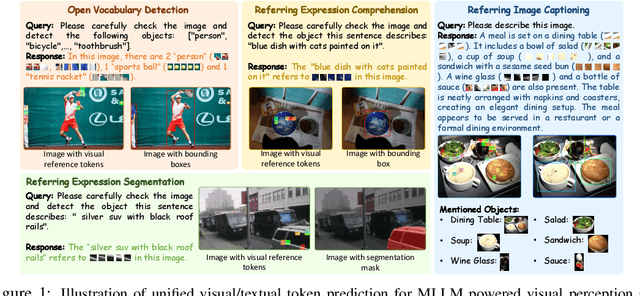
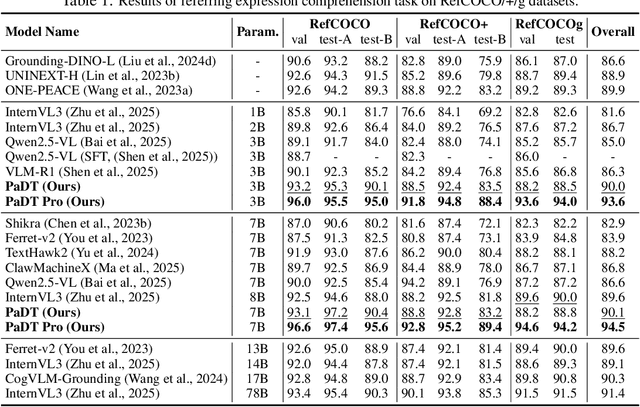
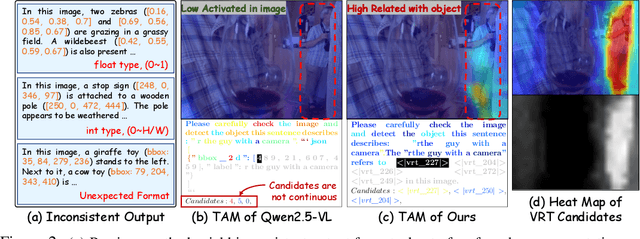
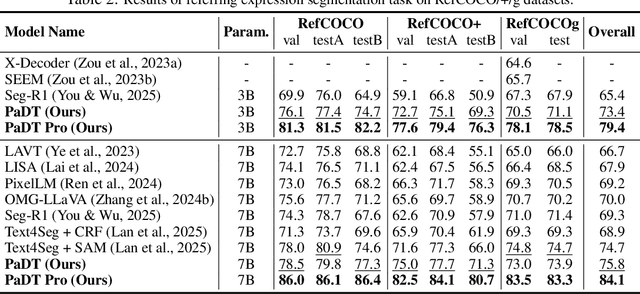
Abstract:Multimodal large language models (MLLMs) have advanced rapidly in recent years. However, existing approaches for vision tasks often rely on indirect representations, such as generating coordinates as text for detection, which limits performance and prevents dense prediction tasks like segmentation. To overcome these challenges, we introduce Patch-as-Decodable Token (PaDT), a unified paradigm that enables MLLMs to directly generate both textual and diverse visual outputs. Central to PaDT are Visual Reference Tokens (VRTs), derived from visual patch embeddings of query images and interleaved seamlessly with LLM's output textual tokens. A lightweight decoder then transforms LLM's outputs into detection, segmentation, and grounding predictions. Unlike prior methods, PaDT processes VRTs independently at each forward pass and dynamically expands the embedding table, thus improving localization and differentiation among similar objects. We further tailor a training strategy for PaDT by randomly selecting VRTs for supervised fine-tuning and introducing a robust per-token cross-entropy loss. Our empirical studies across four visual perception and understanding tasks suggest PaDT consistently achieving state-of-the-art performance, even compared with significantly larger MLLM models. The code is available at https://github.com/Gorilla-Lab-SCUT/PaDT.
Exploring Generalizable Pre-training for Real-world Change Detection via Geometric Estimation
Apr 19, 2025Abstract:As an essential procedure in earth observation system, change detection (CD) aims to reveal the spatial-temporal evolution of the observation regions. A key prerequisite for existing change detection algorithms is aligned geo-references between multi-temporal images by fine-grained registration. However, in the majority of real-world scenarios, a prior manual registration is required between the original images, which significantly increases the complexity of the CD workflow. In this paper, we proposed a self-supervision motivated CD framework with geometric estimation, called "MatchCD". Specifically, the proposed MatchCD framework utilizes the zero-shot capability to optimize the encoder with self-supervised contrastive representation, which is reused in the downstream image registration and change detection to simultaneously handle the bi-temporal unalignment and object change issues. Moreover, unlike the conventional change detection requiring segmenting the full-frame image into small patches, our MatchCD framework can directly process the original large-scale image (e.g., 6K*4K resolutions) with promising performance. The performance in multiple complex scenarios with significant geometric distortion demonstrates the effectiveness of our proposed framework.
RCCFormer: A Robust Crowd Counting Network Based on Transformer
Apr 07, 2025Abstract:Crowd counting, which is a key computer vision task, has emerged as a fundamental technology in crowd analysis and public safety management. However, challenges such as scale variations and complex backgrounds significantly impact the accuracy of crowd counting. To mitigate these issues, this paper proposes a robust Transformer-based crowd counting network, termed RCCFormer, specifically designed for background suppression and scale awareness. The proposed method incorporates a Multi-level Feature Fusion Module (MFFM), which meticulously integrates features extracted at diverse stages of the backbone architecture. It establishes a strong baseline capable of capturing intricate and comprehensive feature representations, surpassing traditional baselines. Furthermore, the introduced Detail-Embedded Attention Block (DEAB) captures contextual information and local details through global self-attention and local attention along with a learnable manner for efficient fusion. This enhances the model's ability to focus on foreground regions while effectively mitigating background noise interference. Additionally, we develop an Adaptive Scale-Aware Module (ASAM), with our novel Input-dependent Deformable Convolution (IDConv) as its fundamental building block. This module dynamically adapts to changes in head target shapes and scales, significantly improving the network's capability to accommodate large-scale variations. The effectiveness of the proposed method is validated on the ShanghaiTech Part_A and Part_B, NWPU-Crowd, and QNRF datasets. The results demonstrate that our RCCFormer achieves excellent performance across all four datasets, showcasing state-of-the-art outcomes.
On the Adversarial Risk of Test Time Adaptation: An Investigation into Realistic Test-Time Data Poisoning
Oct 07, 2024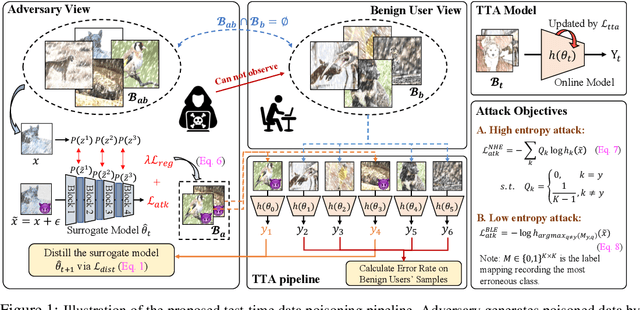



Abstract:Test-time adaptation (TTA) updates the model weights during the inference stage using testing data to enhance generalization. However, this practice exposes TTA to adversarial risks. Existing studies have shown that when TTA is updated with crafted adversarial test samples, also known as test-time poisoned data, the performance on benign samples can deteriorate. Nonetheless, the perceived adversarial risk may be overstated if the poisoned data is generated under overly strong assumptions. In this work, we first review realistic assumptions for test-time data poisoning, including white-box versus grey-box attacks, access to benign data, attack budget, and more. We then propose an effective and realistic attack method that better produces poisoned samples without access to benign samples, and derive an effective in-distribution attack objective. We also design two TTA-aware attack objectives. Our benchmarks of existing attack methods reveal that the TTA methods are more robust than previously believed. In addition, we analyze effective defense strategies to help develop adversarially robust TTA methods.
PS-TTL: Prototype-based Soft-labels and Test-Time Learning for Few-shot Object Detection
Aug 11, 2024Abstract:In recent years, Few-Shot Object Detection (FSOD) has gained widespread attention and made significant progress due to its ability to build models with a good generalization power using extremely limited annotated data. The fine-tuning based paradigm is currently dominating this field, where detectors are initially pre-trained on base classes with sufficient samples and then fine-tuned on novel ones with few samples, but the scarcity of labeled samples of novel classes greatly interferes precisely fitting their data distribution, thus hampering the performance. To address this issue, we propose a new framework for FSOD, namely Prototype-based Soft-labels and Test-Time Learning (PS-TTL). Specifically, we design a Test-Time Learning (TTL) module that employs a mean-teacher network for self-training to discover novel instances from test data, allowing detectors to learn better representations and classifiers for novel classes. Furthermore, we notice that even though relatively low-confidence pseudo-labels exhibit classification confusion, they still tend to recall foreground. We thus develop a Prototype-based Soft-labels (PS) strategy through assessing similarities between low-confidence pseudo-labels and category prototypes as soft-labels to unleash their potential, which substantially mitigates the constraints posed by few-shot samples. Extensive experiments on both the VOC and COCO benchmarks show that PS-TTL achieves the state-of-the-art, highlighting its effectiveness. The code and model are available at https://github.com/gaoyingjay/PS-TTL.
SSLChange: A Self-supervised Change Detection Framework Based on Domain Adaptation
May 28, 2024



Abstract:In conventional remote sensing change detection (RS CD) procedures, extensive manual labeling for bi-temporal images is first required to maintain the performance of subsequent fully supervised training. However, pixel-level labeling for CD tasks is very complex and time-consuming. In this paper, we explore a novel self-supervised contrastive framework applicable to the RS CD task, which promotes the model to accurately capture spatial, structural, and semantic information through domain adapter and hierarchical contrastive head. The proposed SSLChange framework accomplishes self-learning only by taking a single-temporal sample and can be flexibly transferred to main-stream CD baselines. With self-supervised contrastive learning, feature representation pre-training can be performed directly based on the original data even without labeling. After a certain amount of labels are subsequently obtained, the pre-trained features will be aligned with the labels for fully supervised fine-tuning. Without introducing any additional data or labels, the performance of downstream baselines will experience a significant enhancement. Experimental results on 2 entire datasets and 6 diluted datasets show that our proposed SSLChange improves the performance and stability of CD baseline in data-limited situations. The code of SSLChange will be released at \url{https://github.com/MarsZhaoYT/SSLChange}
Toward distortion-aware change detection in realistic scenarios
Jan 10, 2024Abstract:In the conventional change detection (CD) pipeline, two manually registered and labeled remote sensing datasets serve as the input of the model for training and prediction. However, in realistic scenarios, data from different periods or sensors could fail to be aligned as a result of various coordinate systems. Geometric distortion caused by coordinate shifting remains a thorny issue for CD algorithms. In this paper, we propose a reusable self-supervised framework for bitemporal geometric distortion in CD tasks. The whole framework is composed of Pretext Representation Pre-training, Bitemporal Image Alignment, and Down-stream Decoder Fine-Tuning. With only single-stage pre-training, the key components of the framework can be reused for assistance in the bitemporal image alignment, while simultaneously enhancing the performance of the CD decoder. Experimental results in 2 large-scale realistic scenarios demonstrate that our proposed method can alleviate the bitemporal geometric distortion in CD tasks.
CLIP-guided Source-free Object Detection in Aerial Images
Jan 10, 2024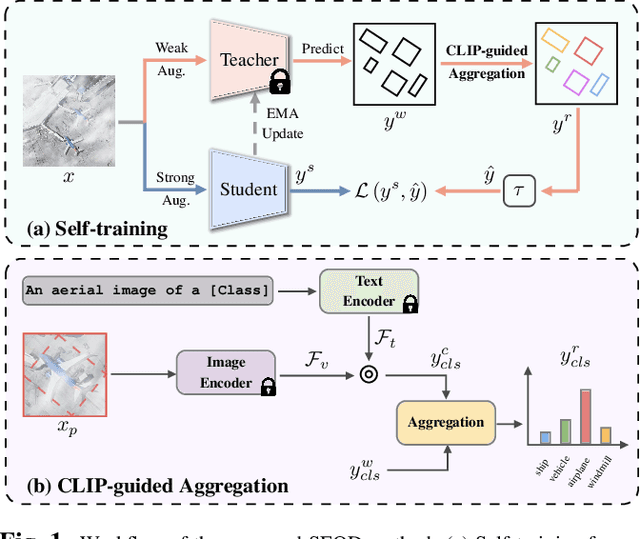

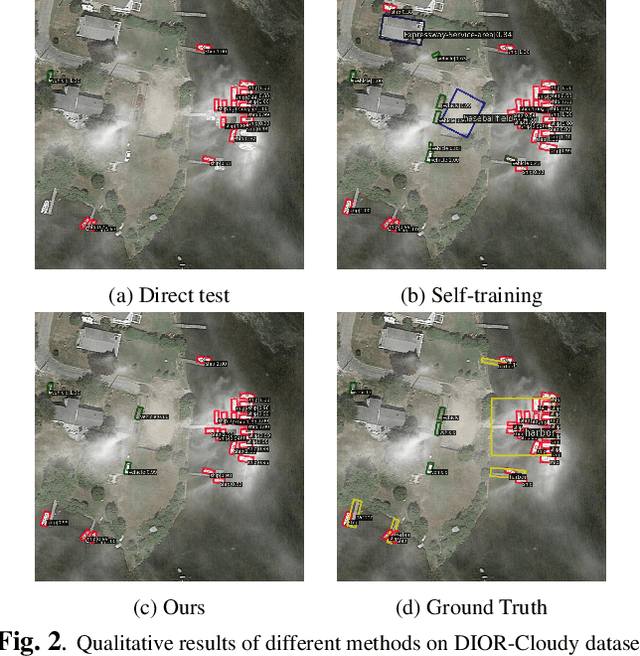
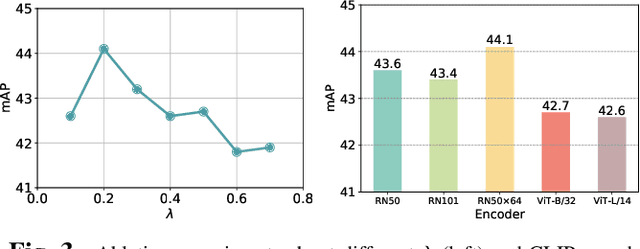
Abstract:Domain adaptation is crucial in aerial imagery, as the visual representation of these images can significantly vary based on factors such as geographic location, time, and weather conditions. Additionally, high-resolution aerial images often require substantial storage space and may not be readily accessible to the public. To address these challenges, we propose a novel Source-Free Object Detection (SFOD) method. Specifically, our approach is built upon a self-training framework; however, self-training can lead to inaccurate learning in the absence of labeled training data. To address this issue, we further integrate Contrastive Language-Image Pre-training (CLIP) to guide the generation of pseudo-labels, termed CLIP-guided Aggregation. By leveraging CLIP's zero-shot classification capability, we use it to aggregate scores with the original predicted bounding boxes, enabling us to obtain refined scores for the pseudo-labels. To validate the effectiveness of our method, we constructed two new datasets from different domains based on the DIOR dataset, named DIOR-C and DIOR-Cloudy. Experiments demonstrate that our method outperforms other comparative algorithms.
Semi-Supervised Object Detection with Uncurated Unlabeled Data for Remote Sensing Images
Oct 09, 2023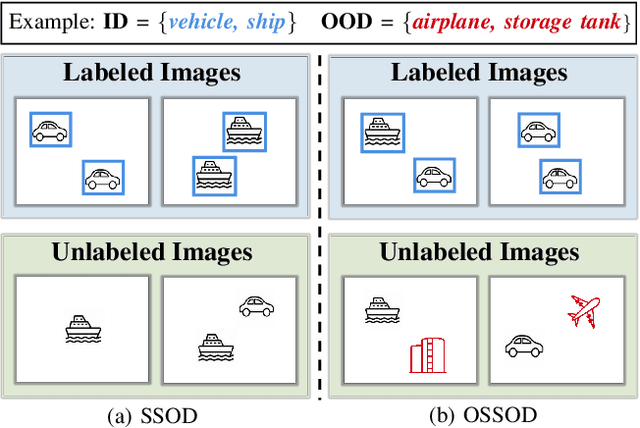

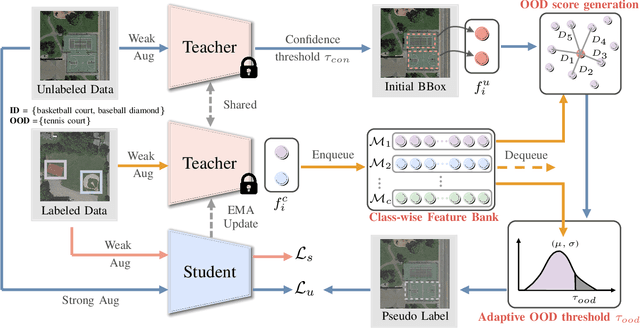
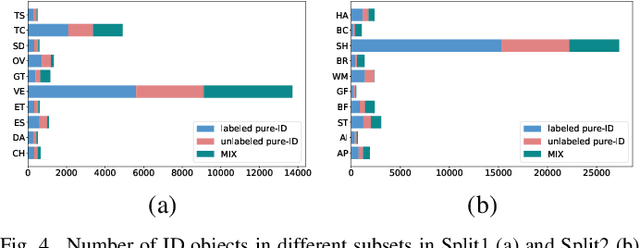
Abstract:Annotating remote sensing images (RSIs) presents a notable challenge due to its labor-intensive nature. Semi-supervised object detection (SSOD) methods tackle this issue by generating pseudo-labels for the unlabeled data, assuming that all classes found in the unlabeled dataset are also represented in the labeled data. However, real-world situations introduce the possibility of out-of-distribution (OOD) samples being mixed with in-distribution (ID) samples within the unlabeled dataset. In this paper, we delve into techniques for conducting SSOD directly on uncurated unlabeled data, which is termed Open-Set Semi-Supervised Object Detection (OSSOD). Our approach commences by employing labeled in-distribution data to dynamically construct a class-wise feature bank (CFB) that captures features specific to each class. Subsequently, we compare the features of predicted object bounding boxes with the corresponding entries in the CFB to calculate OOD scores. We design an adaptive threshold based on the statistical properties of the CFB, allowing us to filter out OOD samples effectively. The effectiveness of our proposed method is substantiated through extensive experiments on two widely used remote sensing object detection datasets: DIOR and DOTA. These experiments showcase the superior performance and efficacy of our approach for OSSOD on RSIs.
Transformation-Invariant Network for Few-Shot Object Detection in Remote Sensing Images
Mar 13, 2023
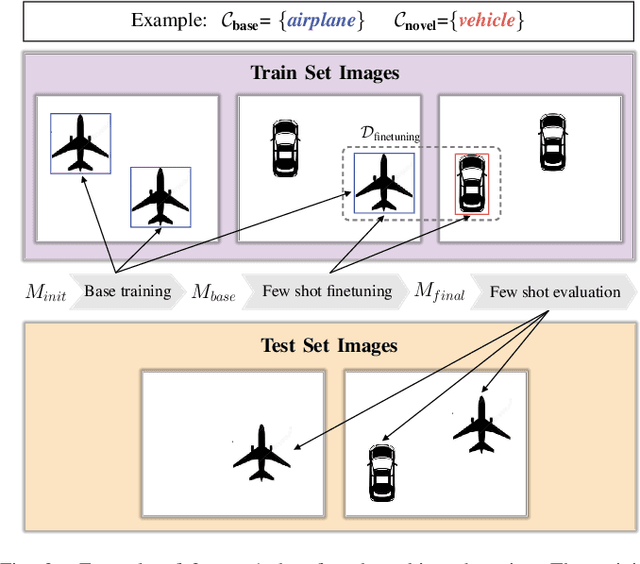
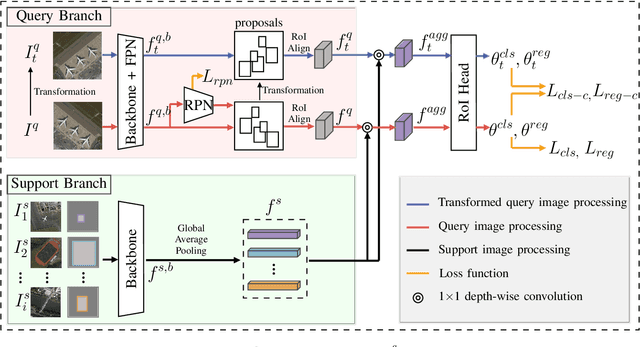
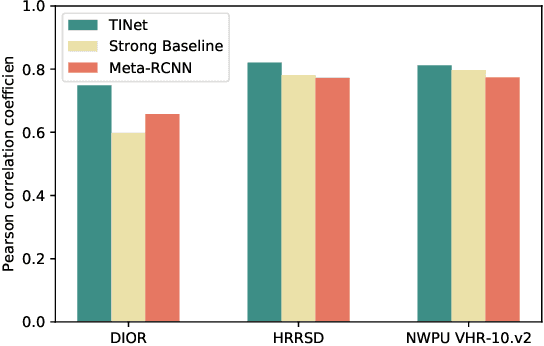
Abstract:Object detection in remote sensing images relies on a large amount of labeled data for training. The growing new categories and class imbalance render exhaustive annotation non-scalable. Few-shot object detection~(FSOD) tackles this issue by meta-learning on seen base classes and then fine-tuning on novel classes with few labeled samples. However, the object's scale and orientation variations are particularly large in remote sensing images, thus posing challenges to existing few-shot object detection methods. To tackle these challenges, we first propose to integrate a feature pyramid network and use prototype features to highlight query features to improve upon existing FSOD methods. We refer to the modified FSOD as a Strong Baseline which is demonstrated to perform significantly better than the original baselines. To improve the robustness of orientation variation, we further propose a transformation-invariant network (TINet) to allow the network to be invariant to geometric transformations. Extensive experiments on three widely used remote sensing object detection datasets, i.e., NWPU VHR-10.v2, DIOR, and HRRSD demonstrated the effectiveness of the proposed method. Finally, we reproduced multiple FSOD methods for remote sensing images to create an extensive benchmark for follow-up works.
 Add to Chrome
Add to Chrome Add to Firefox
Add to Firefox Add to Edge
Add to Edge